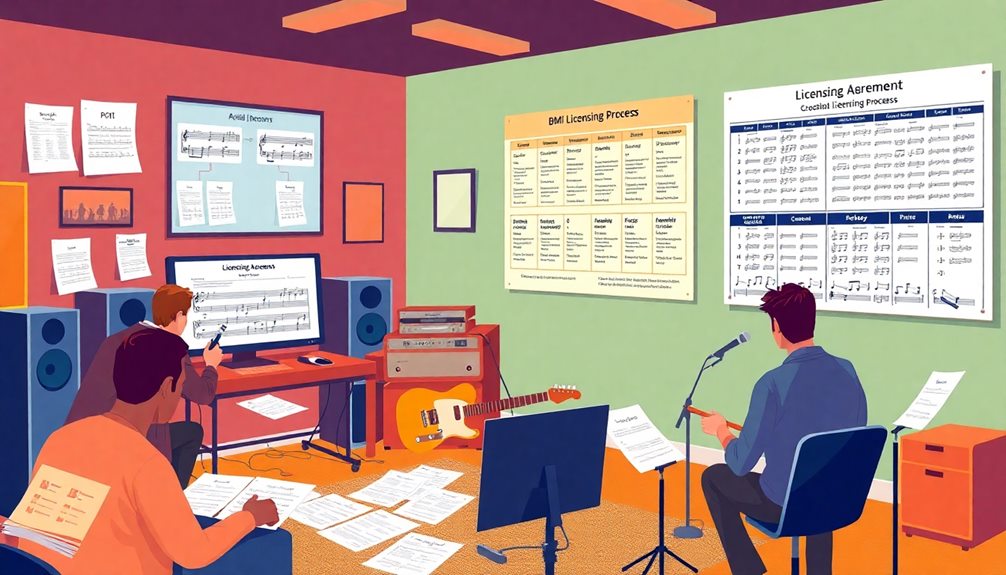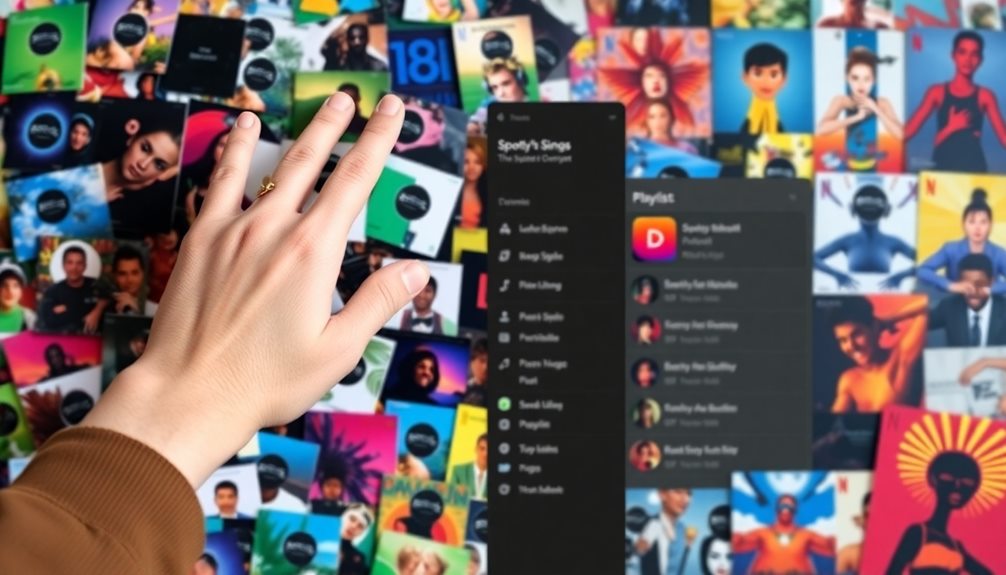BMI in music stands for Broadcast Music, Inc. It's a fantastic organization that helps songwriters and musicians by managing their performance rights. Founded in 1939, BMI makes sure artists get paid when their music is played, whether it's on the radio, in a restaurant, or at a live show. With over 1.4 million members, it supports many genres, promoting talented creators. Members can register their songs for free, earn royalties, and access helpful resources. Exciting, right? If you stick around, you'll discover even more about BMI's role in the music world and how it benefits artists like you!
Key Takeaways
- BMI stands for Broadcast Music, Inc., a nonprofit performing rights organization established in 1939.
- It supports songwriters, composers, and music publishers by managing music rights and licensing.
- BMI generates revenue through blanket licenses, providing a steady income for creators.
- The organization distributes royalties based on music usage, ensuring fair compensation for its members.
- BMI is distinct from other PROs like ASCAP and SESAC, offering free registration for songwriters.
Overview of BMI
Founded in 1939, Broadcast Music, Inc. (BMI) has become a cornerstone in the music industry as a nonprofit performing rights organization. If you love music, you should know about BMI! This amazing organization helps songwriters, composers, and music publishers by managing their music rights.
With over 1.4 million members and more than 22.4 million songs, BMI plays a big role in how music is enjoyed everywhere.
As a performance rights organization, BMI collects licensing fees from businesses that play or use music. This means when you hear your favorite songs in stores or on the radio, those places pay BMI for the right to play them.
BMI then takes those fees and redistributes royalties to its members every quarter, ensuring they get paid for their hard work. In fiscal year 2022, BMI generated a whopping $1.573 billion, with $1.471 billion going back to the creators. How cool is that?
Historical Context

Historically, BMI has played an essential role in shaping the music industry since its inception in 1939. It was created to provide a better option for music licensing, especially when ASCAP raised its fees. You might be surprised to learn that in its early years, BMI focused on genres like blues, jazz, and country music, which were often ignored by other organizations. This helped give a voice to many talented artists.
In 1941, BMI entered a consent decree with the Department of Justice. This was a big deal because it showed BMI's commitment to fair competition in licensing and performance rights.
Over the years, BMI has been involved in important legal cases, such as the 1979 Broadcast Music, Inc. v. CBS, Inc. case, which tackled antitrust laws in the music industry.
As technology changed, BMI adapted too, ensuring its practices kept up with new ways to distribute music. This historical development highlights BMI's dedication to supporting artists and making music more accessible.
Licensing and Royalties

Let's explore how BMI helps keep music playing everywhere!
When businesses want to use music, they pay licensing fees, and BMI makes sure songwriters get their fair share of royalties.
It's exciting to see how technology helps track all this, making sure everyone involved benefits from the music we love!
Licensing Process Overview
Managing the licensing process with BMI can seem intimidating, but it's crucial for any business wanting to play music legally in public spaces. First, you need to identify your type of business. Then, head to BMI's website where you can select the right license for your needs. Completing the application is the next step! This may sound tricky, but it's straightforward.
Once you have your license, remember that compliance is key. You'll want to stick to the licensing terms to avoid any legal trouble. Playing music without a license can lead to significant fines, especially if BMI discovers unauthorized use of songs.
U.S. copyright law requires you to pay fees to rights holders before using music, so it's important to understand this. Licensing fees vary depending on factors like how many locations you operate and the size of your premises. They can range from $182 to $2,515 annually, so be sure to budget for that!
Royalty Distribution Mechanisms
Once you've secured your BMI license, understanding how royalty distribution works is key to maximizing your investment in music. BMI pays out performance royalties quarterly, which means you'll receive payments regularly for your hard work. They track music usage using advanced systems, considering factors like how long your song plays and the audience size. This way, you get a fair share from the blanket license businesses use to play music.
With BMI's blanket licenses, companies can enjoy a wide selection of songs without needing to contact each music publisher individually. This makes it easier for them and guarantees you get paid!
In FY 2022, BMI generated a whopping $1.573 billion, distributing $1.471 billion in royalties to members like you. How exciting is that?
However, the pricing can be a bit tricky. It varies based on the type and size of a business, as well as how they use the music. So, it's a good idea to ask directly for specific rates.
Understanding these royalty distributions helps you make the most of your BMI license and keeps the music playing!
Benefits of BMI Membership

As a member of BMI, you access a wealth of benefits that can greatly enhance your music career. First, you can register your works for free! This means you can earn performance royalties without any upfront costs. That's a fantastic way to start earning money from your music.
Here are three key benefits of BMI membership:
- Quarterly Royalty Distributions: You'll receive payments regularly based on how often your music is played. This provides a steady income stream that can really help you out.
- Career Development Resources: BMI offers workshops and industry events. These opportunities help you grow as an artist and connect with others in the music world.
- Copyright Protection: BMI stands up for your rights, ensuring you get fair compensation for your work. They advocate for your interests, so you can focus on creating.
Additionally, BMI's promotional efforts can get your music noticed, leading to more performances and collaborations.
All these benefits make being a BMI member an exciting opportunity to boost your music career and protect what you create!
Licensing Costs and Factors

Let's explore how licensing costs work with BMI!
Your fees can change based on things like how many locations you have and the size of each place.
Plus, the type of music you want to use—whether it's live, recorded, or for videos—also plays a big part in what you'll pay.
Pricing Structure Overview
When considering BMI's pricing structure, it's essential to recognize that licensing fees vary based on several key factors. Understanding these aspects helps you navigate the costs associated with public performances and music usage.
Here's a quick overview:
- Number of Locations: If you operate a single location, fees start at $182. For up to 9 locations, it can go up to $2,515 annually.
- Square Footage: Larger venues typically pay higher fees due to a bigger audience and more music usage.
- Type of Music Usage: The costs also depend on whether the music is recorded, live, or visual, so it's best to ask BMI directly for a tailored quote.
BMI's pricing model focuses on blanket licenses instead of individual song licenses. This approach simplifies the process for you while ensuring BMI earns a steady income.
Plus, compared to other PROs, BMI is competitive. With access to 22.4 million songs, you'll find a great selection for your events.
Influencing Factors Explained
Several key factors influence BMI licensing costs, making it crucial for businesses to understand their specific scenario.
First, think about the number of locations you operate. If you have multiple venues, your BMI licensing costs can increase considerably. For example, the annual licensing fee for up to 9 locations could be around $2,515, but if you have 10 or more, it might start as low as $182.
Next, consider the type of music you're using. Are you playing recorded tunes, hosting live bands, or showing music videos? Larger events with bigger audiences often lead to higher fees. This is because BMI wants to guarantee artists receive fair rights for their work.
It's also important to note that because BMI's pricing model is quite complex, it's best to inquire directly for precise quotes tailored to your business.
Understanding these factors will help you make informed decisions about music licensing. Knowing what affects the costs means you can plan better and enjoy the music at your venues while staying within budget.
License Fee Examples
Understanding the nuances of BMI license fees can save you both time and money. When you're planning to use music, knowing the costs involved is essential. Here are a few examples to help you get started:
- Small Businesses: If you operate up to 9 locations, expect to pay about $2,515 annually for your BMI license.
- Larger Operations: For 10 or more locations, the cost can drop to around $182 per location, making it more affordable as you grow!
- Music Usage Type: The kind of music you use—whether it's recorded, live, or for videos—can change your license fee per year, so ask for specific quotes.
Both ASCAP and BMI collect royalties from businesses using their music catalogs. It's important to get your music licenses right to avoid fines.
The Licensing Process

Steering through the licensing process with BMI is essential for businesses that want to use music legally. First, you'll need to identify your type of business.
After that, head over to the BMI website to find specific licensing information that fits your needs. It's important to choose the right music license based on how you plan to use the music.
Next, complete your application and make the necessary payment. Remember, following the licensing terms is critical! If you don't, you could face fines for unauthorized music usage, which can really add up.
BMI actively monitors businesses for any misuse of music, so it's best to play by the rules.
Small businesses sometimes have exceptions when using broadcast radio or TV. However, these exceptions don't cover streaming services, CDs, or subscription-based music platforms.
It's essential to stay compliant!
Comparing BMI With Other PROS

When comparing BMI with other performance rights organizations (PROs), you'll find distinct differences in their structures and offerings. BMI music stands out, especially for songwriters looking for accessibility and support.
Here are three key points to evaluate:
- Membership Fees: Unlike ASCAP, which charges membership fees, BMI offers free registration. This makes it easier for new songwriters to join and get started without financial barriers.
- Royalty Distribution: BMI distributed about $1.471 billion in royalties in FY 2022, showing its effectiveness in collecting and sharing performance royalties. ASCAP, while similar, has a more variable fee structure based on venue size, which can be tricky for some.
- Membership Model: SESAC is an invitation-only PRO, providing personalized service but limiting who can join. In contrast, BMI and ASCAP have open enrollment, welcoming all songwriters.
Financial Performance of BMI

BMI continues to demonstrate robust financial performance, solidifying its position as a leader in the music rights industry. In FY 2022, BMI reported impressive revenues of $1.573 billion! This shows just how well the organization is doing.
During the same year, BMI distributed $1.471 billion in royalties to its members. This commitment to fairly compensating music creators is one of the reasons so many songwriters love BMI.
Regarding revenue management, it's essential for organizations like BMI to maintain a well-structured budget, ensuring they meet their financial obligations while supporting their artists a solid budget strategy.
As the largest performing rights organization in the U.S., BMI represents over 1.4 million songwriters and manages more than 22.4 million musical works. That's a huge responsibility!
BMI's revenue model is smart too. It primarily relies on blanket licenses instead of individual song licenses. This approach creates a steady income stream for the organization and makes the licensing process easier for businesses.
BMI's financial performance also reflects its ability to adapt to changes in the music industry. It responds to technological advancements and shifts in music distribution, ensuring it stays relevant and effective.
With these solid achievements, BMI continues to be a key player in the music rights industry, benefiting both songwriters and businesses alike!
Awards and Recognition

Recognizing excellence in songwriting and composition is a vital part of BMI's mission. They celebrate the talents of songwriters through various awards. Every year, BMI hosts award shows to honor the most-performed songs across many genres.
You might be excited to learn about some of their key recognition programs:
- BMI Icon Award: This prestigious award honors songwriters who've made significant contributions to the music industry.
- Annual Award Shows: These events recognize the best songs in genres like Latin, Pop, and Country.
- The BMI Lehman Engel Musical Theatre Workshop: This program has even won a Tony Award and a Drama Desk Award, showcasing its importance in musical theatre.
Through these awards, BMI shines a light on the hard work and creativity of songwriters. They also collaborate with other organizations to promote diversity and inclusion in music, ensuring that everyone gets the recognition they deserve.
Whether you're a fan or an aspiring songwriter, it's inspiring to see how BMI values contributions to the music world. So, keep an eye out for those awards—they celebrate the heart and soul of music!
Frequently Asked Questions
What Does BMI Mean in Music?
When you hear BMI in music, it refers to a major organization that protects the rights of songwriters and artists. It licenses music for public performances, ensuring creators get paid fairly for their work.
What's the Difference Between ASCAP and BMI?
Did you know BMI manages over 22.4 million songs? The key difference between ASCAP and BMI lies in their fee structures; BMI offers a no-fee membership, while ASCAP charges an initial fee for joining.
What Does BMI Stand for in Music Awards?
BMI in music awards stands for Broadcast Music, Inc. You'll find it celebrates songwriters, composers, and publishers, recognizing their contributions through annual events that highlight the most-performed songs across various genres.
Who Needs a BMI Music License?
Did you know that 90% of businesses playing music publicly need a BMI music license? If you own a bar, gym, or event venue, you must get one to comply with copyright laws and support artists.
Conclusion
To sum up, BMI plays an essential role in the music world. It helps artists get paid for their hard work, making sure they reap the rewards of their creativity. Joining BMI can really be the cherry on top for musicians. With their support, you can focus on what you love—creating awesome music! So, if you're looking to soar in your music career, teaming up with BMI might just be the best move you'll ever make!









